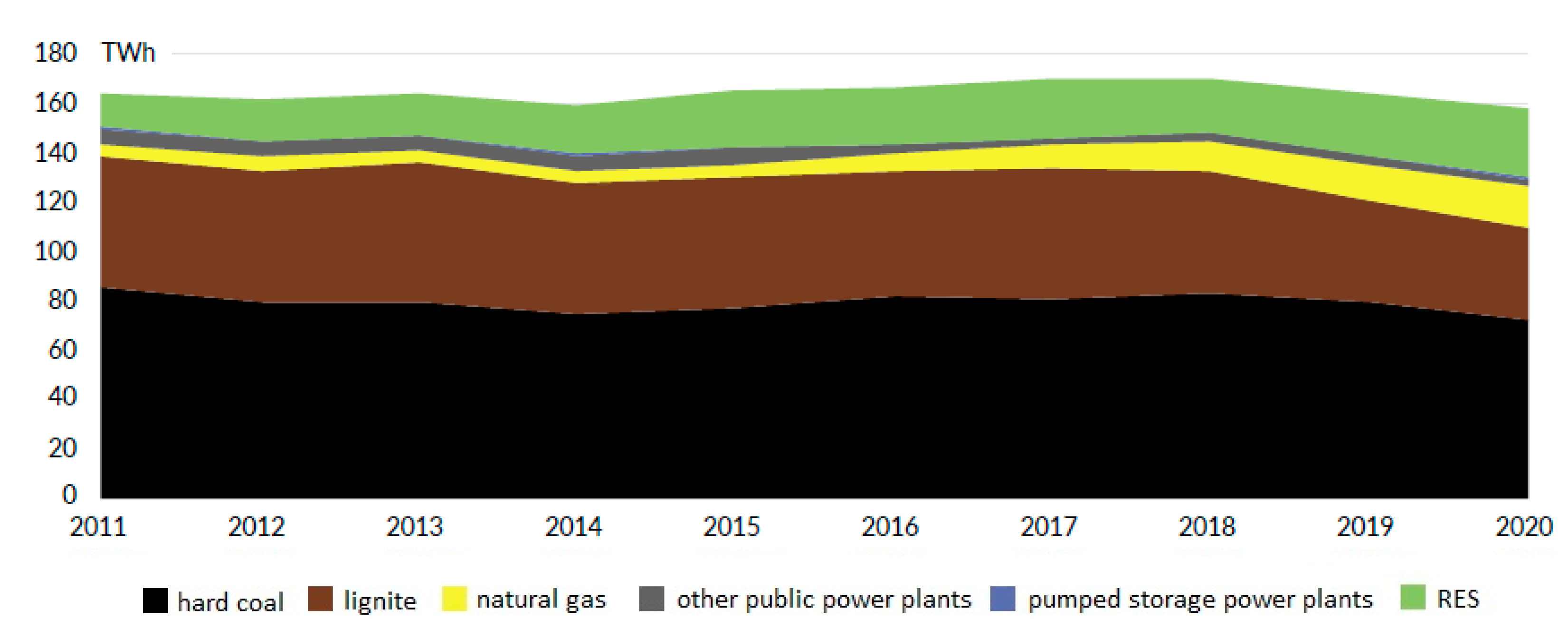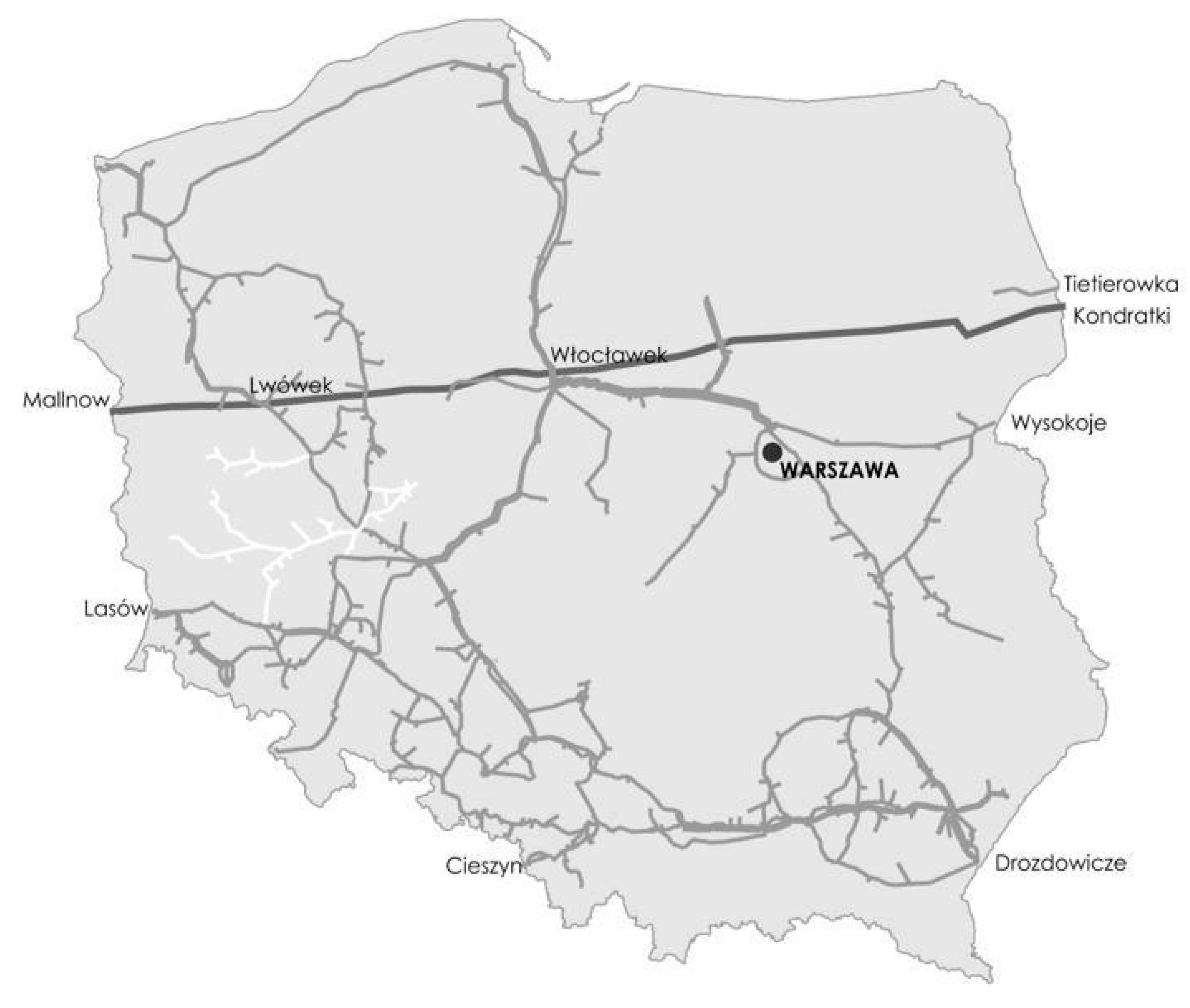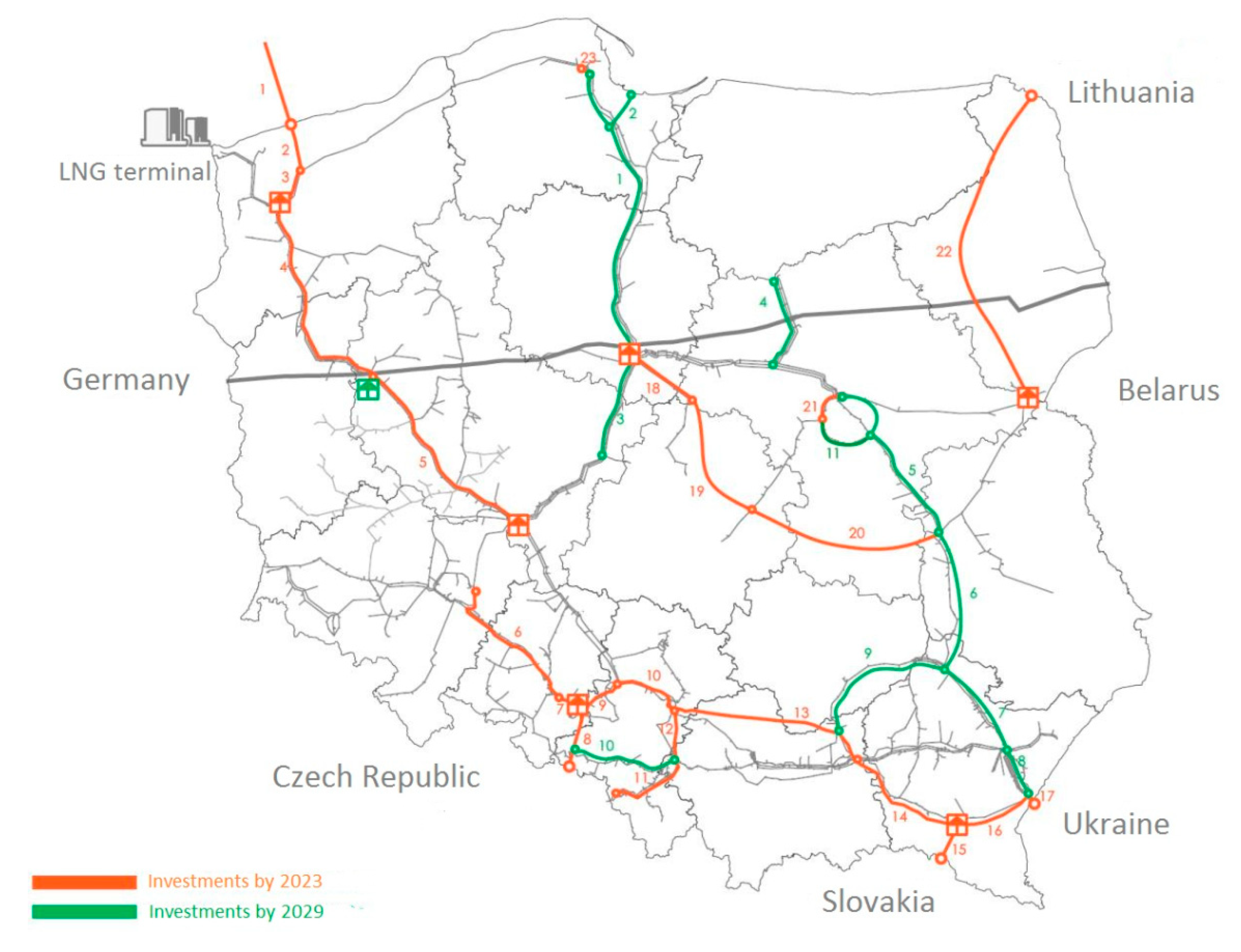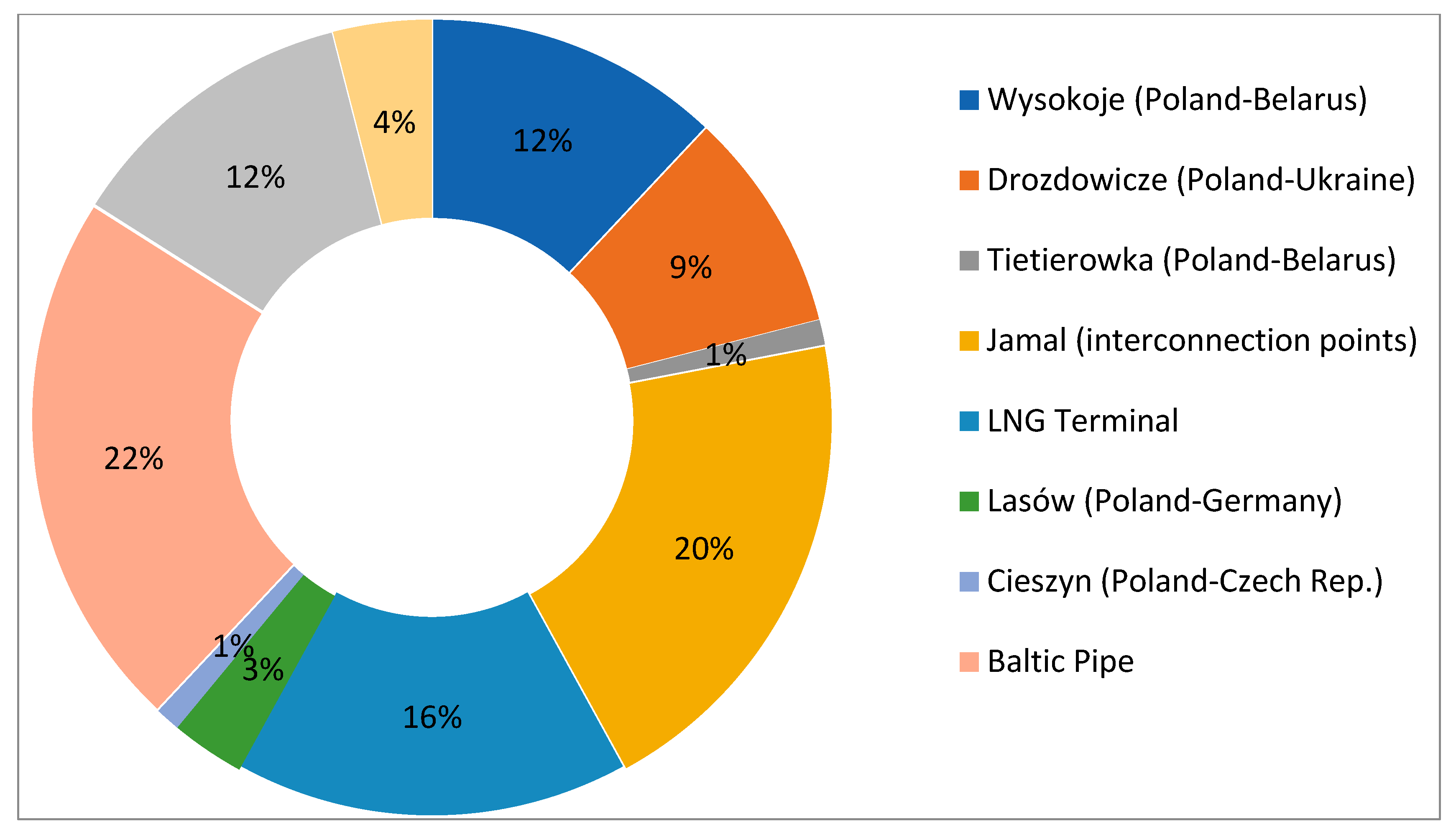The North-South Gas Corridor in the Context of Poland’s Gas Transmission System—A Perfect Opportunity to Diversify Gas Resources
Abstract
1. Introduction
2. Polish Energy Sector—Current and Future Status
2.1. Coal
2.2. Natural Gas
2.3. Renewable Energy Sources
2.4. Energy Policy of Poland until 2040 in the Context of the Gas Sector
3. The Gas Transmission System in Poland, and the North-South Gas Corridor
3.1. The Gas Transmission System in Poland—Current and Future Status
- 2023 Time frame—focuses on the existing investment projects described in the Development Plan for years 2018–2027 as well as on actions taken in relation to the diversification of the natural gas supply;
- 2029 Time frame—takes into consideration the investment objectives, the success of which will depend on how well the natural gas market is developed in Poland and in the CEE region [40] (p. 6).
3.2. The Gas Transmission System in Poland—The Effects of the Investment
4. The North-South Gas Corridor—A Perfect Opportunity to Diversify Gas Resources
4.1. The North-South Gas Corridor—Concept and Its Implementation
4.2. The North-South Gas Corridor—Importance for Poland and Central European Countries
5. Conclusions
Funding
Institutional Review Board Statement
Informed Consent Statement
Data Availability Statement
Conflicts of Interest
References
- Sadik-Zada, E.R.; Gatto, A. Energy Security Pathways in South East Europe: Diversification of the Natural Gas Supplies, Energy Transition, and Energy Futures. In From Economic to Energy Transition. Three Decades of Transitions in Central and Eastern Europe; Mišík, M., Oravcová, V., Eds.; Springer International Publishing: Cham, Switzerland, 2021; pp. 491–514. [Google Scholar] [CrossRef]
- Holz, F.; Richter, P.M.; Egging, R. The Role of Natural Gas in a Low-Carbon Europe: Infrastructure and Supply Security. Energy J. 2016, 37, 33–59. [Google Scholar] [CrossRef]
- Papadis, E.; Tsatsaronis, G. Challenges in the decarbonization of the energy sector. Energy 2020, 205, 118025. [Google Scholar] [CrossRef]
- Bataille, C.; Åhman, M.; Neuhoff, K.; Nilsson, L.J.; Fischedick, M.; Lechtenböhmer, S.; Solano-Rodriquez, B.; Denis-Ryan, A.; Stiebert, S.; Waisman, H.; et al. A review of technology and policy deep decarbonization pathway options for making energy-intensive industry production consistent with the Paris Agreement. J. Clean. Prod. 2018, 187, 960–973. [Google Scholar] [CrossRef]
- Wilson, C.; Grubler, A.; Bento, N.; Healey, S.; De Stercke, S.; Zimm, C. Granular technologies to accelerate decarbonization. Science 2020, 368, 36–39. [Google Scholar] [CrossRef] [PubMed]
- Karlsson, I.; Rootzén, J.; Toktarova, A.; Odenberger, M.; Johnsson, F.; Göransson, L. Roadmap for Decarbonization of the Building and Construction Industry—A Supply Chain Analysis Including Primary Production of Steel and Cement. Energies 2020, 13, 4136. [Google Scholar] [CrossRef]
- Mercader-Moyano, P.; Roldán-Porras, J. Evaluating Environmental Impact in Foundations and Structures through Disaggregated Models: Towards the Decarbonisation of the Construction Sector. Sustainability 2020, 12, 5150. [Google Scholar] [CrossRef]
- Mallouppas, G.; Yfantis, E. Decarbonization in Shipping Industry: A Review of Research, Technology Development, and Innovation Proposals. J. Mar. Sci. Eng. 2021, 9, 415. [Google Scholar] [CrossRef]
- Csedő, Z.; Zavarkó, M.; Vaszkun, B.; Koczkás, S. Hydrogen Economy Development Opportunities by Inte-Organizational Digital Knowledge Networks. Sustainability 2021, 13, 9194. [Google Scholar] [CrossRef]
- Haas, T.; Sander, H. Decarbonizing Transport in the European Union: Emission Performance Standards and the Perspectives for a European Green Deal. Sustainability 2020, 12, 8381. [Google Scholar] [CrossRef]
- Misztal, A.; Kowalska, M.; Fajczak-Kowalska, A.; Strunecky, O. Energy Efficiency and Decarbonization in the Context of Macroeconomic Stabilization. Energies 2021, 14, 5197. [Google Scholar] [CrossRef]
- Gillingham, K.; Huang, P. Is Abundant Natural Gas a Bridge to a Low-carbon Future or a Dead-end? Energy J. 2019, 40, 1–26. [Google Scholar] [CrossRef]
- Kosowski, P.; Kosowska, K. Valuation of Energy Security for Natural Gas—European Example. Energies 2021, 14, 2678. [Google Scholar] [CrossRef]
- Yermakov, V.; Sobczak, K. Russia-Poland gas relationship: Risk and uncertainties of the ever after. The Oxford Institute for Energy Studies. Energy Insight 2020, 70, 1–32. Available online: https://www.oxfordenergy.org/wpcms/wp-content/uploads/2020/06/Russian-Poland-gas-relationship-risks-and-uncertainties-Insight-70.pdf (accessed on 25 July 2021).
- Jakóbik, W. Poland Will Need 2.6–8.4 Billion Cubic Meters More Gas (Polska będzie potrzebowła o 2.6–8.4 miliardów metrów sześciennych gazu więcej); Biznes Alert: Warsaw, Poland, 2019; Available online: https://biznesalert.pl/polska-gaz-26-84-mld-m-szesc-wiecej-gaz-system-plan/ (accessed on 25 July 2021). (In Polish)
- Sobczyk, W.; Sobczyk, E. Varying the Energy Mix in the EU-28 and in Poland as a Step towards Sustainable Development. Energies 2021, 14, 1502. [Google Scholar] [CrossRef]
- European Council. Council of the European Union. Latest EU Policy Actions on Climate Change; European Council. Council of the European Union: Brussels, Belgium, 2021; Available online: https://www.consilium.europa.eu/en/policies/climate-change/eu-climate-action/ (accessed on 25 July 2021).
- United Nations. Article 2. Paris Agreement; United Nations: Paris, France, 2015; Available online: https://unfccc.int/sites/default/files/english_paris_agreement.pdf (accessed on 25 July 2021).
- European Commission. The European Green Deal, Communication from the Commission to the European Parliament, the European Council, the Council. In Proceedings of the European Economic and Social Committee and the Committee of the Regions, COM (2019) 640 Final, Brussels, Belgium, 11 December 2019; European Commission: Brussels, Belgium, 2019. Available online: https://ec.europa.eu/info/sites/default/files/european-green-deal-communication_en.pdf (accessed on 25 July 2021).
- Tichý, L.; Dubský, Z. Russian energy discourse on the V4 countries. Energy Policy 2019, 137, 111128. [Google Scholar] [CrossRef]
- Mišík, M. On the way towards the Energy Union: Position of Austria, the Czech Republic and Slovakia towards external energy security integration. Energy 2016, 111, 68–81. [Google Scholar] [CrossRef]
- Szuflicki, M.; Malon, A.; Tymiński, M. The Balance of Mineral Resources Deposit in Poland as of 31 December 2020 (Bilans zasobów złóż kopalnych wg stanu na 31 XII 2020); Państwowy Instytut Geologiczny—Państwowy Instytut Badawczy, Państwowa Służba Geologiczna: Warszawa, Poland, 2021. Available online: http://geoportal.pgi.gov.pl/css/surowce/images/2020/bilans_2020.pdf (accessed on 25 July 2021). (In Polish)
- Gawlik, L.; Mokrzycki, E. Changes in the Structure of Electricity Generation in Poland in View of the EU Climate Package. Energies 2019, 12, 3323. [Google Scholar] [CrossRef]
- Nyga-Łukaszewska, H.; Aruga, K.; Stala-Szlugaj, K. Energy Security of Poland and Coal Supply: Price Analysis. Sustainability 2020, 12, 2541. [Google Scholar] [CrossRef]
- Jędra, M. Energy Transformation in Poland, 2021st ed.; (Transformacja Energetyczna w Polsce. Edycja 2021); Forum Energii: Warsaw, Poland, 2021; Available online: https://www.forum-energii.eu/pl/analizy/transformacja-2021 (accessed on 25 July 2021). (In Polish)
- Adamus, W.; Florkowski, W.J. The evolution of shale gas development and energy security in Poland: Presenting a hierarchical choice of priorities. Energy Res. Soc. Sci. 2016, 20, 168–178. [Google Scholar] [CrossRef]
- LaBelle, M. A state of fracking: Building Poland’s national innovation capacity for shale gas. Energy Res. Soc. Sci. 2017, 23, 26–35. [Google Scholar] [CrossRef]
- Polish Geological Institute–National Research Institute. Assessment of Recoverable Natural Gas and Crude Oil Resources in Lower Paleozoic Shale Formations of Poland. Baltic-Podlasie-Lublin Basin. (Ocena zasobów Wydobywalnych gazu Ziemnego i ropy Naftowej w Formacjach Łupkowych Dolnego Paleozoiku w Polsce); Państwowy Instytut Geologiczny–Państwowy Instytut Badawczy: Warszawa, Poland, 2012. Available online: https://www.pgi.gov.pl/docman-tree/aktualnosci-2012/zasoby-gazu/771-raport-pl/file.html (accessed on 25 July 2021). (In Polish)
- Polish Oil Mining and Gas Extraction SA. Stable Increase in the Production of Natural Gas and Crude Oil (Stabilny Wzrost Wydobycia Gazu Ziemnego i Ropy Naftowej); Polskie Górnictwo Naftowe i Gazownictwo SA: Warszawa, Poland, 2019; Available online: https://pgnig.pl/aktualnosci/-/news-list/id/stabilny-wzrost-wydobycia-gazu-ziemnego-i-ropy-naftowej/newsGroupId/10184 (accessed on 25 July 2021). (In Polish)
- Polish Oil Mining and Gas Extraction SA. PGNiG: Less Gas from Russia, LNG Imports are Growing (PGNiG: Mniej Gazu z Rosji, Rośnie Import LNG); Polskie Górnictwo Naftowe i Gazownictwo SA: Warszawa, Poland, 2020; Available online: https://pgnig.pl/aktualnosci/-/news-list/id/pgnig-mniej-gazu-z-rosji-rosnie-import-lng/newsGroupId/10184?changeYear=2020¤tPage=1 (accessed on 25 July 2021). (In Polish)
- Macuk, R. Energy Transformation in Poland, 2020th ed.; (Transformacja Energetyczna w Polsce. Edycja 2020); Forum Energii: Warsaw, Poland, 2021; Available online: https://www.forum-energii.eu/pl/dane-o-energetyce/za-rok-2019 (accessed on 25 July 2021). (In Polish)
- Cieślik, T.; Górowska, K.; Metelska, K.; Szurlej, A. Natural gas consumption by voivodships. (Zużycie gazu ziemnego w podziale na województwa). Nierówności Społeczne A Wzrost Gospod. 2018, 54, 190–205. Available online: http://yadda.icm.edu.pl/yadda/element/bwmeta1.element.ekon-element-000171518258 (accessed on 25 July 2021). (In Polish) [CrossRef]
- Polish Oil Mining and Gas Extraction SA. Company Presentation. (Prezentacja Spółki); Polskie Górnictwo Naftowe i Gazownictwo SA: Warszawa, Poland, 2019; Available online: https://pgnig.pl/documents/10184/2580770/Company-Overview_PL_May2019.pdf/5da1eb13-8aaf-47ef-93b2-a8a18a6aae5c (accessed on 25 July 2021). (In Polish)
- Pietrzak, M.; Igliński, B.; Kujawski, W.; Iwański, P. Energy Transition in Poland—Assessment of the Renewable Energy Sector. Energies 2021, 14, 2046. [Google Scholar] [CrossRef]
- Marks-Bielska, R.; Bielski, S.; Pik, K.; Kurowska, K. The Importance of Renewable Energy Sources in Poland’s Energy Mix. Energies 2020, 13, 4624. [Google Scholar] [CrossRef]
- Electric Market. In June, Almost 540 MW of Installed Capacity RES Was Added. (W Czerwcu Przybyło Prawie 540MW Mocy Zainstalowanej OZE); Rynek Elektryczny: Warszawa, Poland, 2021; Available online: https://www.rynekelektryczny.pl/moc-zainstalowana-oze-w-polsce/ (accessed on 25 July 2021). (In Polish)
- Ministry of Climate and Environment. Poland’s Energy Policy Until 2040. (Ministerstwo Klimatu i Środowiska. Polityka Energetyczna Polski do 2040 r.); Ministry of Climate and Environment: Warszawa, Poland, 2021. Available online: https://www.gov.pl/web/klimat/polityka-energetyczna-polski (accessed on 25 July 2021). (In Polish)
- Ruszel, M. Evaluation of the Security of Natural Gas Supplies to Poland: The Present State and the 2025 Perspective. (Ocena bezpieczeństwa dostaw gazu ziemnego do Polski—Stan obecny i perspektywa do 2025 r.). Polityka Energetyczna–Energy Policy J. 2017, 20, 5–22. Available online: https://epj.min-pan.krakow.pl/Evaluation-of-the-security-of-natural-gas-supplies-to-Poland-nthe-present-state-and,96155,0,2.html (accessed on 25 July 2021). (In Polish).
- Olkuski, T.; Sikora, A.; Sikora, M.P.; Szurlej, A. The forecasted production, consumption, and net exports of energy resources in Poland. (Prognozy wydobycia, konsumpcji i saldo wymiany surowców energetycznych w Polsce). Polityka Energetyczna–Energy Policy J. 2017, 20, 41–58. Available online: https://epj.min-pan.krakow.pl/The-forecasted-production-consumption-and-net-exports-of-nenergy-resources-in-Poland,96167,0,2.html (accessed on 25 July 2021). (In Polish).
- Gas Transmission Operator GAZ-SYSTEM SA. National Ten-Year Transmission System Development Plan. Development Plan for Satisfying the Current and Future Transmission Demand for Natural Gas for 2020–2029. Excerpt. (Krajowy Dziesięcioletni plan Rozwoju Systemu Przesyłowego. Plan Rozwoju w Zakresie Zaspokojenia Obecnego i Przyszłego Zapotrzebowania na Paliwa Gazowe na lata 2020-2029. Wyciąg); GAZ-SYSTEM SA: Warszawa, Poland, 2019; Available online: https://www.gaz-system.pl/fileadmin/Krajowy_Dziesiecioletni_Plan_Rozwoju_Systemu_Przesylowego_na_lata_2020-2029_01.pdf (accessed on 25 July 2021). (In Polish)
- Kuś, P. Construction of a Gas Interconnection between Poland and Slovakia; GAZ-SYSTEM SA: Warszawa, Poland, 2019; Available online: https://en.gaz-system.pl/fileadmin/pliki/open-season/02_CONSTRUCTION_OF_A_GAS_INTERCONNECTION_BETWEEN_POLAND_AND_SLOVAKIA.pdf (accessed on 25 July 2021).
- International Energy Agency. Lithuania 2021, Energy Policy Review; International Energy Agency (IEA): Paris, France, 2021; Available online: https://iea.blob.core.windows.net/assets/4d014034-0f94-409d-bb8f-193e17a81d77/Lithuania_2021_Energy_Policy_Review.pdf (accessed on 25 July 2021).
- Baltic Pipe Project. Offshore Gas Pipeline-Implementation Stage. Available online: https://www.baltic-pipe.eu/wp-content/uploads/2020/08/BalticPipe-Project-Implementation-Stage.pdf (accessed on 25 July 2021).
- Gas Transmission Operator GAZ-SYSTEM SA. Gaz-System and Amber Grid Made Positive Investment Decision Regarding Construction of Gas Interconnector between Poland and Lithuania; GAZ-SYSTEM SA: Warszawa, Poland, 2018; Available online: https://en.gaz-system.pl/press-centre/news/information-for-the-media/artykul/202756/ (accessed on 25 July 2021).
- Visegrad Group. Declaration of the Budapest V4+ Energy Security Summit; Visegrad Group: Budapest, Hungary, 2010; Available online: https://www.visegradgroup.eu/2010/declaration-of-the (accessed on 25 July 2021).
- Hebda, W. Energy strategy of the Republic of Bulgaria until the year 2020. (Strategia energetyczna Republiki Bułgarii do 2020 roku). Polityka Energetyczna–Energy Policy J. 2015, 18, 111–128. Available online: https://epj.min-pan.krakow.pl/Energy-strategy-of-the-Republic-of-Bulgaria-until-nthe-year-2020,96087,0,2.html (accessed on 25 July 2021). (In Polish).
- Hebda, W. Politics and Energy Sector in the Selected Countries of Southeast Europe. Serbia, Croatia, Bulgaria, Greece, Romania (Polityka oraz sektor energetyczny w wybranych państwach Europy Południowo-Wschodniej. Serbia, Chorwacja, Bułgaria, Grecja, Rumunia); Księgarnia Akademicka: Kraków, Poland, 2019; pp. 145–168. Available online: https://ruj.uj.edu.pl/xmlui/handle/item/245414 (accessed on 25 July 2021). (In Polish)
- Pavlović, B.; Ivezić, D.; Živković, M. Prioritization of strategic measures for strengthening the security of supply of the Serbian natural gas sector. Energy Policy 2021, 148, 111936. [Google Scholar] [CrossRef]
- Dominiak, I.; North-South Corridor. The International Gas Main with Poland in the Lead Role. (Korytarz Północ-Południe. Międzynarodowa Magistrala Gazowa z Polską w roli Głównej); Krakow, Poland, 3 December 2020. Available online: https://wydarzenia.interia.pl/artykul-sponsorowany/news-korytarz-polnoc-poludnie-miedzynarodowa-magistrala-gazowa-z-,nId,4893296 (accessed on 25 July 2021). (In Polish).
- Rqiq, Y.; Beyza, J.; Yusta, J.M.; Bolado-Lavin, R. Assessing the Impact of Investments in Cross-Border Pipelines on the Security of Gas Supply in the EU. Energies 2020, 13, 2913. [Google Scholar] [CrossRef]
- Gas Transmission Operator GAZ-SYSTEM SA. North-South Gas Corridor; GAZ-SYSTEM SA: Warszawa, Poland, 2021; Available online: https://en.gaz-system.pl/nasze-inwestycje/integracja-z-europejski-systemem/korytarz-polnoc-poludnie/ (accessed on 25 July 2021).
- Net4gas. Czech-Polish Gas Interconnector; Net4gas: Prague, Czech Republic, 2016; Available online: https://www.net4gas.cz/files/en/projects/n4g_pci_info_leaflet_storkii_en.pdf (accessed on 25 July 2021).
- Net4gas. Bidirectional Austrian-Czech Interconnection; Net4gas: Prague, Czech Republic, 2016; Available online: https://www.net4gas.cz/files/en/projects/n4g_pci_info_leaflet_baci_en.pdf (accessed on 25 July 2021).
- Sawicki, B. The Construction of the New Gas Connection between Poland and the Czech Republic Is Suspended (Realizacja Nowego Połączenia Gazowego Między Polską a Czechami Zostaje Zawieszona); Biznes Alert: Warsaw, Poland, 2020; Available online: https://biznesalert.pl/gazociag-polska-czechy-stork-ii-zawieszony-gaz-systemnet4gas-gaz-energetyka/ (accessed on 25 July 2021). (In Polish)
- Mišík, M.; Nosko, A. The Eastring gas pipeline in the context of the Central and Eastern European gas supply challenge. Nat. Energy 2017, 11, 844–848. [Google Scholar] [CrossRef]
- SEE Energy News. Romania-Hungary Gas Interconnection Not Enough Demand for Capacity Increase; Serbia Energy: Belgrade, Serbia, 2020; Available online: https://serbia-energy.eu/romania-hungary-gas-interconnection-not-enough-demand-for-capacity-increse/ (accessed on 25 July 2021).
- Reuters. Hungary to Triple Capacity of Gas Pipeline to Slovakia; Reuters. Commodities News: London, UK, 2020; Available online: https://www.reuters.com/article/hungary-slovakia-gas-interconnector-idAFL8N2DF2M5 (accessed on 25 July 2021).
- Plinacro. Reverse Flow with Hungary Enabled; Plinacro: Zagreb, Croatia, 2020; Available online: https://www.plinacro.hr/default.aspx?id=1131 (accessed on 25 July 2021).
- European Commission. First Croatian LNG Terminal Officially Inaugurated in Krk Island; European Commision: Brussels, Belgium, 2021; Available online: https://ec.europa.eu/inea/en/news-events/newsroom/first-croatian-lng-terminal-officially-inaugurated-krk-island (accessed on 25 July 2021).
- Eustream. Gas Interconnection Poland-Slovakia; Eustream: Bratislava, Slovak Republic, 2017; Available online: https://www.eustream.sk/files/docs/eng/SKPL/PLSK_booklet_2017.pdf (accessed on 25 July 2021).
- Gas Transmission Operator GAZ-SYSTEM SA. Our Investments; GAZ-SYSTEM SA: Warszawa, Poland, 2021; Available online: https://en.gaz-system.pl/nasze-inwestycje/ (accessed on 25 July 2021).
- Jirušek, M. The attitude of the Visegrad Group Countries towards Russian Infrastructural Projects in the gas sector. Energy Policy 2020, 139, 111340. [Google Scholar] [CrossRef]
- Božić, F.; Karasalihović Sedlar, D.; Smajla, I.; Ivančić, I. Analysis of Changes in Natural Gas Physical Flows for Europe via Ukraine in 2020. Energies 2021, 14, 5175. [Google Scholar] [CrossRef]
- Kiss, A.; Selei, A.; Tóth, B.T. A Top-Down Approach to Evaluating Cross-Border Natural Gas Infrastructure Project in Europe. Energy J. 2016, 37, 61–79. [Google Scholar] [CrossRef]
- Figulová, A.; Wertlen, D. Between Energy Security and Energy Transition: Visegrad Gas Hub. In From Economic to Energy Transition. Three Decades of Transitions in Central and Eastern Europe; Mišík, M., Oravcová, V., Eds.; Springer International Publishing: Cham, Switzerland, 2021; pp. 315–339. [Google Scholar] [CrossRef]
- Bieliszczuk, B. Three Seas Initiative: Benefits for Regional Gas Markets and the EU (Trójmorze: Współpraca na Rzecz Unijnego i Regionalnego Rynku Gazu); The Polish Institute of International Affairs: Warszawa, Poland, 2017; Available online: https://pism.pl/publikacje/Tr_jmorze__wsp__praca_na_rzecz_unijnego_i_regionalnego_rynku_gazu (accessed on 25 July 2021). (In Polish)
- Ministry of Climate and Environment. Polish Nuclear Power Program—2020 Version (Ministerstwo Klimatu i Środowiska. Program Polskiej Energetyki Jądrowej—Wersja z 2020 r); Ministry of Climate and Environment: Warszawa, Poland, 2021. Available online: https://www.gov.pl/web/polski-atom/program-polskiej-energetyki-jadrowej-2020-r (accessed on 25 July 2021). (In Polish)
- Gierszewski, J.; Młynarkiewicz, Ł.; Nowacki, T.R.; Dworzecki, J. Nuclear Power in Poland’s Energy Transition. Energies 2021, 14, 3626. [Google Scholar] [CrossRef]
- Holz, F.; Hirschhausen, C.; Kemfert, C. Perspectives of the European Natural Gas Markets Until 2025. Energy J. 2009, 30, 137–150. [Google Scholar] [CrossRef]
- Hartley, P.R.; Medlock, K.B. Potential Futures for Russian Natural Gas Exports. Energy J. 2009, 30, 73–96. [Google Scholar] [CrossRef]
- Ritz, R.A. A Strategic Perspective on Competition between Pipeline Gas and LNG. Energy J. 2019, 40, 195–220. [Google Scholar] [CrossRef]
- Hinchey, N. The Impact of Securing Alternative Energy Sources on Russian-European Natural Gas Pricing. Energy J. 2018, 39, 87–102. [Google Scholar] [CrossRef]
- Kratochvíl, P.; Mišík, M. Bad external actors and good nuclear energy: Media discourse on energy supplies in the Czech Republic and Slovakia. Energy Policy 2020, 136, 111058. [Google Scholar] [CrossRef]
- Dyduch, J.; Skorek, A. Go South! Southern dimension of the V4 states’ energy policy strategies—An assessment of viability and prospect. Energy Policy 2020, 140. [Google Scholar] [CrossRef]
- Baltensperger, T.; Füchslin, R.M.; Krütli, P.; Lygeros, J. European Union gas market development. Energy Econ. 2017, 66, 466–479. [Google Scholar] [CrossRef][Green Version]
- Ruszel, M. The significance of the Baltic Sea Region for natural gas supplies to the V4 countries. Energy Policy 2020, 146. [Google Scholar] [CrossRef]









| 2010 | 2011 | 2012 | 2013 | 2014 | 2015 | 2016 | 2017 | 2018 | 2019 | 2020 | |
|---|---|---|---|---|---|---|---|---|---|---|---|
| Import | 10.1 | 10.9 | 11.0 | 10.9 | 9.7 | 9.3 | 11.5 | 13.7 | 13.5 | 14.8 | 14.8 |
| Production | 4.2 | 4.3 | 4.3 | 4.2 | 4.0 | 4.0 | 3.9 | 3.8 | 3.8 | 3.8 | 3.8 |
| Import/Production | 5.9 | 6.6 | 6.7 | 6.7 | 5.7 | 5.3 | 7.6 | 9.9 | 9.7 | 11.0 | 11.0 |
| Investment by 2023 | |
|---|---|
| 1. Baltic Pipe | 275 km (Baltic Sea) |
| 2. Niechorze-Płoty | 41 km |
| 3. Goleniów-Płoty | 42 km |
| 4. Goleniów-Lwówek | 69 km |
| 5. Lwówek-Odolanów | 168 km |
| 6. Zdzieszowice-Wrocław | 130 km |
| 7. Zdzieszowice-Kędzierzyn | 17 km |
| 8. Kędzirzyn-Poland border (Poland-Czech Rep.) | 55 km |
| 9. Tworóg-Kędzierzyn | 43 km |
| 10. Tworóg-Tworzeń | 55 km |
| 11. Skoczów-Komorowice-Oświęcim | 53 km |
| 12. Oświęcim-Tworzeń | 44 km |
| 13. Pogórska Wola-Tworzeń | 168 km |
| 14. Strachocina-Pogórska Wola | 97 km |
| 15. Strachocina-Poland border (Poland-Slovakia) | 61 km |
| 16. Hermanowice-Strachocina | 72 km |
| 17. Hermanowice-Poland border (Poland-Ukraine) | 2 km |
| 18. Gustorzyn-Leśniewice | 54 km |
| 19. Leśniewice-Rawa Mazowiecka | 100 km |
| 20. Rawa Mazowiecka-Wronów | 154 km |
| 21. Rembelszczyzna-Mory | 28 km |
| 22. Hołowczyce-Poland border (Polad-Lithuania) | 343 km |
| 23. Wiczlino-Reszki | 8 km |
| Investment by 2029 | |
| 1. Reszki-Gustorzyn | 250 km |
| 2. Gdańsk-Kolnik | 35 km |
| 3. Adamów-Gustorzyn | 82 km |
| 4. Płońsk-Uniszki Zawadzkie | 72 km |
| 5. Rembelszczyzna-Wronów | 135 km |
| 6. Rozwadów-Końskowola-Wronów | 103 km |
| 7. Jarosław-Rozwadów | 60 km |
| 8. Hermanowice-Jarosław | 39 km |
| 9. Swarzów-Zborów-Rozwadów | 130 km |
| 10. Racibórz-Oświęcim | 90 km |
| 11. Mory-Wola Karczewska | 91 km |
| Name | Construction Status |
|---|---|
| Czeszów-Wierzchowice gas pipeline | Built in 2017 |
| Czeszów-Kiełczów gas pipeline | Built in 2018 |
| Lwówek-Odolanów gas pipeline (Krobia-Odolanów section) | Built in 2018 |
| Zdzieszowice-Kędzierzyn gas pipeline | Built in 2019 |
| Lwówek-Odolanów gas pipeline (Lwówek-Krobia section) | Built in 2019 |
| Tworóg-Kędzierzyn gas pipeline | Built in 2020 |
| Zdzieszowice-Wrocław gas pipeline (Zdzieszowice-Brzeg section) | Built in 2020 |
| Zdzieszowice-Wrocław gas pipeline (Brzeg-Zębice-Kiełczów section) | Built in 2020 |
| Hermanowice-Strachocina gas pipeline | Built in 2020 |
| Tworóg-Tworzeń gas pipeline | Built in 2021 |
| Kędzierzyn gas compression station | In construction (supposed in 2021) |
| Pogórska Wola-Tworzeń gas pipeline (Braciejówka-Tworzeń section) | In construction (supposed in 2021) |
| Pogórska Wola-Tworzeń gas pipeline (Pałecznica-Braciejówka section) | In construction (supposed in 2021) |
| Pogórska Wola-Tworzeń gas pipeline (Pogórska Wola-Pałecznic section) | In construction (supposed in 2021) |
| Strachocina-Pogórska Wola gas pipeline | In construction (supposed in 2021) |
| Strachocina gas compression station and hub | In construction (supposed in 2021) |
| Poland-Slovakia gas interconnector | In construction (supposed in 2022) |
| 2005 | 2010 | 2015 | 2020 | 2025 | 2030 | 2035 | 2040 | |
|---|---|---|---|---|---|---|---|---|
| Gas-fired power plants | 0 | 0 | 0 | 0 | 1900 (3.45%) | 1900 (3.22%) | 3039 (4.79%) | 3260 (4.52%) |
| Gas combined heat and power | 760 (2.36%) | 807 (2.42%) | 928 (2.41%) | 2688 (5.53%) | 3807 (6.9%) | 4371 (7.4%) | 4100 (6.47%) | 5261 (7.3%) |
| Other power plants | 31,493 (97.64%) | 32,513 (97.58%) | 36,392 (97.59%) | 45,968 (94.47%) | 49,460 (89.65%) | 52,802 (89.38%) | 56,252 (88.74%) | 63,582 (88.18%) |
| All power plants | 32,253 (100%) | 33,320 (100%) | 37,290 (100%) | 48,656 (100%) | 55,167 (100%) | 59,073 (100%) | 63,391 (100%) | 72,103 (100%) |
Publisher’s Note: MDPI stays neutral with regard to jurisdictional claims in published maps and institutional affiliations. |
© 2021 by the author. Licensee MDPI, Basel, Switzerland. This article is an open access article distributed under the terms and conditions of the Creative Commons Attribution (CC BY) license (https://creativecommons.org/licenses/by/4.0/).
Share and Cite
Hebda, W. The North-South Gas Corridor in the Context of Poland’s Gas Transmission System—A Perfect Opportunity to Diversify Gas Resources. Energies 2021, 14, 7188. https://doi.org/10.3390/en14217188
Hebda W. The North-South Gas Corridor in the Context of Poland’s Gas Transmission System—A Perfect Opportunity to Diversify Gas Resources. Energies. 2021; 14(21):7188. https://doi.org/10.3390/en14217188
Chicago/Turabian StyleHebda, Wiktor. 2021. "The North-South Gas Corridor in the Context of Poland’s Gas Transmission System—A Perfect Opportunity to Diversify Gas Resources" Energies 14, no. 21: 7188. https://doi.org/10.3390/en14217188
APA StyleHebda, W. (2021). The North-South Gas Corridor in the Context of Poland’s Gas Transmission System—A Perfect Opportunity to Diversify Gas Resources. Energies, 14(21), 7188. https://doi.org/10.3390/en14217188






